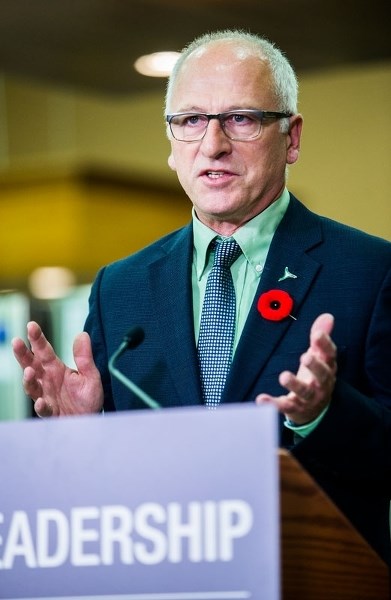Albertans will have green energy dollars knocking on their door next year as part of the province's plans to turn carbon tax cash into energy savings.
Alberta Environment Minister Shannon Phillips sketched out three energy efficiency programs Thursday at the Trail Appliances South store in Edmonton.
The province's carbon tax is projected to raise $645 million over five years for energy efficiency programs. Thursday's event was the first indication on how that cash would be spent.
"Alberta is late to this game, but we know that offering energy efficiency programs will reduce energy costs for consumers," Phillips said.
Co-ordinating these programs will be Energy Efficiency Alberta, a new agency launched by Phillips Thursday that is chaired by former Gazette reporter David Dodge.
"This is going to be an independent agency with one job, and that's to save Albertans money on energy," Dodge said.
Dodge said he'd met many energy innovators in the last five years through his work on the Green Energy Futures media project and knew first-hand that people were excited about reducing their energy use.
"There are so many opportunities in Alberta."
Godo Stoyke of the eco-audit firm Carbon Busters was at Thursday's announcement and noted that it had been four years since Alberta had an energy rebate program and almost 20 since it had an energy efficiency department.
"We finally have a program again."
Three ways to save
Phillips outlined three programs that will launch next year with the carbon tax, the details of which would be hammered out by Energy Efficiency Alberta in the next two months.
The direct install residential program will have people visit homes on request to install, for free, low-cost energy upgrades such as LED light bulbs and low-flow showerheads, she said.
"There will also be folks actually going out and talking to consumers, going and talking to people on their doorsteps to say, 'Would you like these no-cost initiatives?'"
B.C. offers a similar service where people will do a mini energy audit of your home and install simple upgrades for you, said Jesse Row of the Alberta Energy Efficiency Alliance, who was at Thursday's event.
"It's a foot in the door for energy efficiency," he said, one that gives people a chance to learn about bigger steps they can take to save energy.
The residential consumer products program will give customers point-of-sale rebates on products such as efficient lighting, insulation and appliances, Phillips said.
Stoyke said that such rebates were a good idea, as they will reduce the sticker shock that often comes with efficient appliances and have lower administrative costs than mail-in rebates.
Dodge said he and his fellow board members at the agency will have to figure out which items get what rebate in the next two months.
"You can surely expect to see rebates on many items we see in this store," he said, and rebates that would produce the best climate bang for their buck.
Phillips said the third program will offer rebates to businesses, non-profits and institutions for high-efficiency products and heating and lighting systems.
These programs will initially be delivered through private contractors as they are in other jurisdictions for efficiency's sake, Phillips said. A request for proposals to run the programs will go out this week.
"We know that these programs work and we want to get them out as soon as possible."
Other energy-saving plans will emerge once the province's energy efficiency advisory panel issues its final report in a few weeks.
Energy efficiency is a no-brainer and one way to diversify Alberta's economy, Dodge said.
"It's the cheapest way to save energy, it's the best way to reduce emissions, and as it turns out, it's great because it helps you save money."
A 2015 report by Dunsky Energy Consulting suggests that Alberta could save about $6.3 billion a year in energy costs, create 15,000 jobs and prevent 14 megatonnes of greenhouse gas emissions (equivalent to six per cent of Alberta's 2012 emissions) by 2030 through energy efficiency investment. This investment would start at $30 million in 2016 and ramp up to $670 million by 2021.




